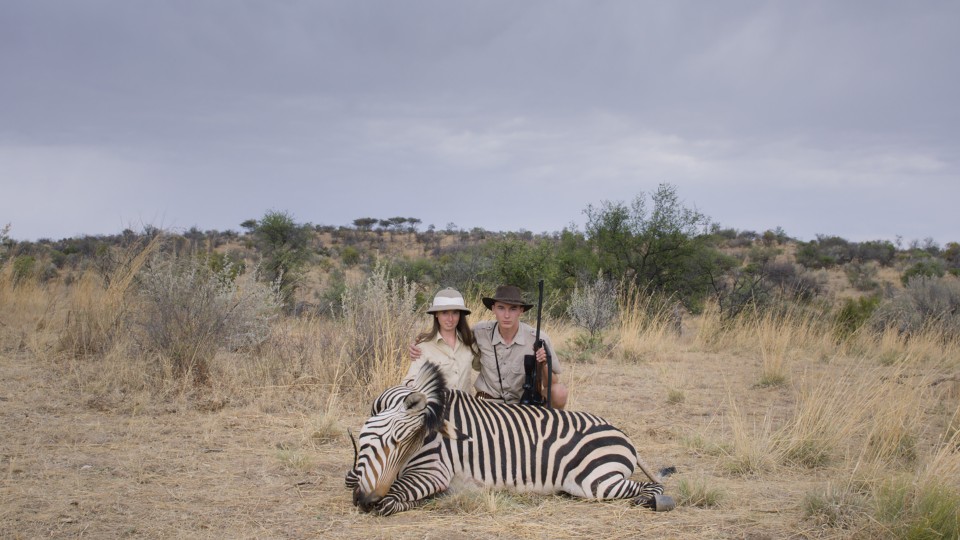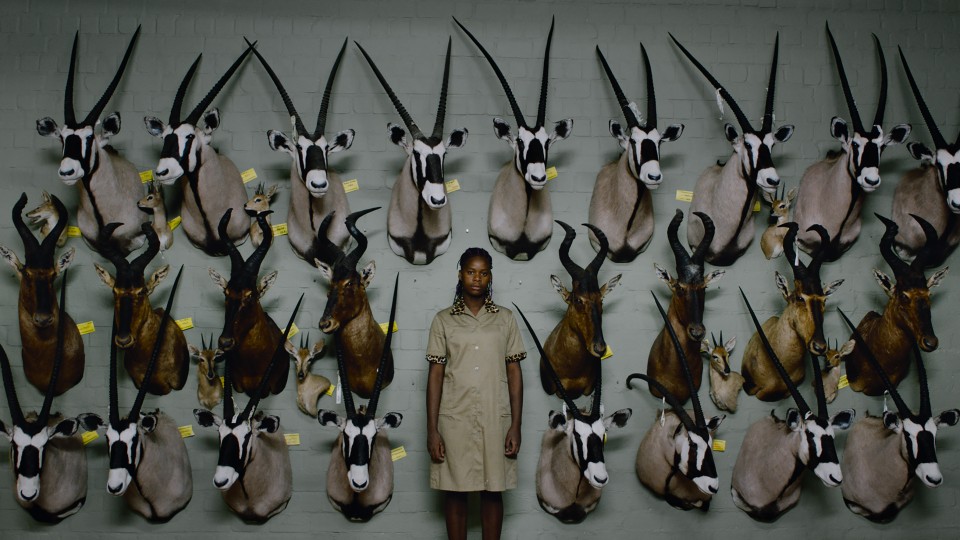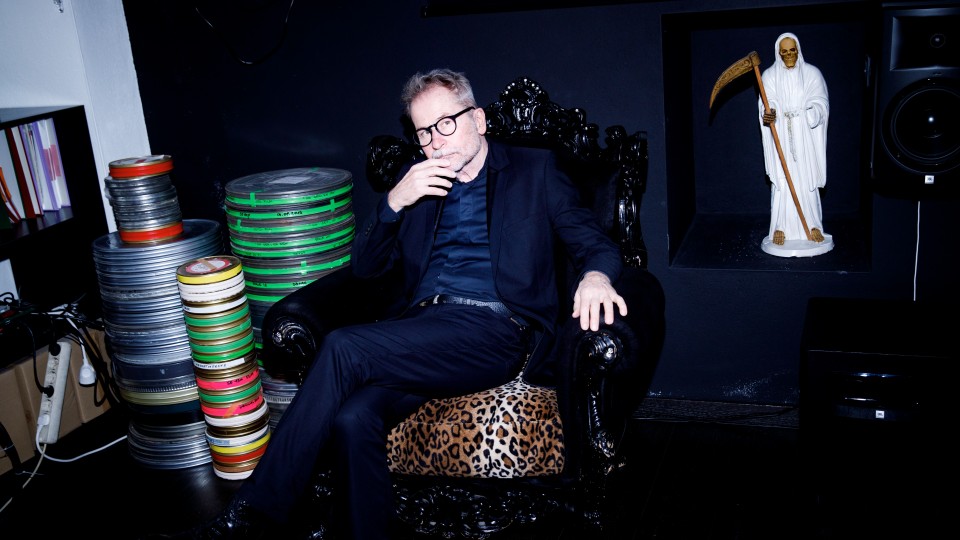In SAFARI Ulrich Seidl goes on the trail of European hobby hunters as they stalk big game in Africa, and in the vast expanses where
the natural world is unlimited he captures a thoughtful portrait of domination and mortality.
The logline describes your film as "a vacation movie about killing". It's a reference to two fundamentally contradictory concepts:
relaxing by escaping from everyday life – and killing. Does this dramatic formulation relate to the numerous contradictions
embodied in hunting itself? Contradictions which prompted you to explore the subject in film?
ULRICH SEIDL: I'd always had the idea of making a film about hunting. At the same time, I was planning a series of films for TV on the subject
of vacations. My last film, In the Basement, which featured one couple whose cellar was full of hunting trophies, prompted me to bring the two subjects together in a
film and explore tourism hunting in Africa. I'm interested in hunting because it shows something about human nature; it confronts
the subject of killing and the relationship between people and the animal world while also throwing up questions about the
power human beings hold over nature
Where and in which form did you explore this modern form of big-game hunting?
ULRICH SEIDL: We filmed in South Africa and Namibia, but there are hunting farms in many countries of Africa. Our approach to the concept
(which I wrote together with Veronika Franz, as always), wasn't hunting in the sense of the Big Five (that is, lions, leopards,
elephants, buffaloes and rhinoceroses) but the less spectacular variety: average hunting, you might say. This kind of hunting
vacation is increasingly popular, because it has become affordable. These days somebody with an average salary can travel
to Africa as a hunter and shoot animals – something that used to be reserved for the aristocracy and people with plenty of
money and power.
To what extent are these hunting farms run by white people?
ULRICH SEIDL: Entirely – or at least, while we were doing our research we didn't come across any hunting farms run by black people. In Namibia,
which used to be German South-West Africa, the German colonialists originally started cattle farms. Then, after three or four
generations, many of those major landowners switched to hunting farms, because it's a far more profitable line of business.
The sheer size of these farms is difficult to imagine from our perspective. When you come through the gate of a farm you have
to drive another half an hour to reach the farmhouse. And the whole area is enclosed by game fences.
How far does tourism hunting remain within the bounds of legality, respecting the principles of sustainability and species
protection?
ULRICH SEIDL: The form of tourism hunting you see in this film is completely legal. The wild animals are the property of the people who
run the farms: they are indigenous to the area, or they have been bred there or bought. There are what is known as trophy
hunts, which have to be registered with the authorities, who check up on them. And then there are so-called meat hunts, which
serve to reduce overpopulation among certain animals. The hunters don’t have to pay for them. And for some animals, such as
wild cats, you need a permit before the hunt, because only a certain number are allowed to be killed on each farm each year.
Is it hunting as such which says so much about human nature or in particular this kind of hunting, which not only illustrates
the domination of human beings over nature/animals/creation but also the domination of white western tourists over the black
inhabitants?
ULRICH SEIDL: Even though hunting and killing is the primary subject, naturally that aspect also runs right through the film. Making a film
that simply criticises hunting would be too easy for me, and it wouldn't really seem right. The dominant relationship between
white people and black people is one aspect of the film that everyone can perceive and draw his own conclusions from. If you
look closely the film reveals very clearly that it's the black people who spot the animals, it's the black people who are
the best trackers, but they never take charge, never could take charge. During the hunt they assist the hunt escorts, and
back at the farm they’re the employees who have to cut up the dead animals, among other things.
The core protagonists in Safari are a family of four who appear to have a genuinely ethical approach to hunting. The hunting vacation they spent together
seems to strengthen the family relationships, life within the family and individual personalities. What features came together
in this family to make you give them a central role in the film?
ULRICH SEIDL: Every film gradually takes on certain aspects of the people you choose for it. When you are going through that decision-making
process you try to estimate the potential, to assess how productive it will be to work with them. Various questions are crucial
here – to choose one example: How natural are they in front of the camera? The particularly interesting point about our family
in the film was that as well as including men and women it also features two generations. That meant there were more layers
to the act of observation.
"The act of killing is involved, but it's only a small part of the hunt," says one of the members of the family. When you
listen to the protagonists in the film, you’re struck by the particular rhetoric and language they use; the animal, the living
being is objectified by calling it "a piece", and instead of using the word "kill" they use "bag", or instead of "dead" they
use "perished". What role does this language play in the process of legitimisation, which apparently everyone employs to justify
this behaviour?
ULRICH SEIDL: If the animals aren’t given their proper names, so the zebra is just described as "a piece", this objectification can also
establish the necessary distance required for the act of killing. This "hunters’ language" really does find a euphemism for
the things. They don't even use the word "blood" – they talk about "sweat" instead. Incidentally, when the film was subtitled
into English and Italian for the Venice Film Festival, we discovered this hunting jargon was far more pronounced in German.
In the scenes where white people are standing in front of the camera we hear them talk, but when black people are being filmed
they don’t speak. Even though they remain silent, they seem to provide a very powerful statement about the relationship between
black and white people here.
ULRICH SEIDL: I think it would be completely wrong, as a filmmaker, to claim some kind of quasi-objectivity and contrive things here so
black people were also allowed to speak. In my view the black people in the film have precisely the position that they have
on the hunting farms: they don't say anything, because they don't have anything to say or aren't allowed to say anything.
Which naturally isn't right, but unfortunately that's the reality.
The rhythm in Safari alternates between the strict framing of the tableau scenes and stalking, which is pursued/observed with a very calm hand
camera. It's a dynamic of constricting and expanding, like the rhythm of breathing, which gives this film – reflecting as
it does upon life and death – an appropriate form. What were the long, virtually unpredictable shooting sessions like? Which challenges did the camera face?
ULRICH SEIDL: To be perfectly honest, we didn't engage in any long, theoretical discussions in advance to decide on a formal structure for
the film. We decided to go along on the stalking expeditions, and to keep the focus on the people involved. As a rule, animal
films and hunting films don't do that: the animals are the centre of attention, perhaps involving a telephoto lens. The gestures
and activities of the people are only marginal. Our approach was fundamentally different: I wanted to follow the people on
a hunt, to capture what they feel before they fire a shot and what they feel afterwards, and what they feel when they stand
in front of the animal they’ve just killed and get somebody to take a picture of them.
The waiting, the stalking, the watching, the shooting – all the activities involved in the hunt are virtually duplicated by
the work of the cameraman. And the term "safari" is also used for a photographic safari. Did you sense this double meaning,
this "hunting for a shot" while you were out on the hunt?
ULRICH SEIDL: That wasn't my intention, although it's certainly true that in English and some other languages the world "shoot" is used
for making films. For me it suggests more the idea of a "snapshot". A photographer is there at exactly the right moment and
takes a quick picture. It's true that I also regard my work is something that arises from a particular moment. On the other
hand, our pictures are prepared, not left to chance. Even though in the stalking sequences it looks as though we simply follow
the others with a hand camera, using the hand camera has been planned – by Wolfgang Thaler, the cameraman, and by me.
After a successful hunt the sensation of being dominant is epitomised and captured forever: the photograph of the hunter clutching
a rifle, with the dead animal at his feet, appears to be an indispensable feature at the end of each hunt. What did you discover
about your protagonists’ motivation in going hunting?
ULRICH SEIDL: Hunting is primarily a human instinct; that was my starting point, and you can also feel it in the film. Aiming the gun, firing
a shot, the emotion you feel afterwards – there's a huge tension associated with these activities. This awareness and the
intention of killing an animal mean the situation is charged with powerful emotions, accentuating the feeling of relief as
soon as the animal has been killed. The protagonists in the film also refer to that in their statements. The question that
arises as a consequence is: "Why does someone kill when there’s no need?" I tend to think it's something to do with a person's
desire to exercise power over nature. But it's a question that I'm still dealing with.
The professional butchering of the animal's body brings it home to us in a very immediate way that the creature’s soul has
departed, its existence has come to an end. Essentially, in SAFARI you have created a particularly thoughtful film about existence itself.
ULRICH SEIDL: That wasn't all an intention we could have put in writing before we started filming. I'd say it developed like that because
hunting necessarily means being confronted with death. I simply wanted to make a film about hunting which involved the audience
and encouraged people to give the subject some thought.
Was it more difficult to find people who would talk about their passion for hunting than it was to find people willing to
open the doors of their basements?
ULRICH SEIDL: It was harder, due to the media response that was triggered throughout Austria by In the Basement. When I was about to start filming SAFARI, In the Basement had just been released in the cinemas, flanked by a scandal that everybody in Austria had got wind of. Including the protagonists
for SAFARI, who had already been chosen. Essentially, in this case my "target group" was much easier to access than with In the Basement. After all, there are plenty of hunters in Austria. The ones who ventured to talk about their hobby in front of the camera
knew it was a touchy subject. But they're convinced they aren’t doing anything wrong or illegal, or anything people could
object to on moral grounds. And they stick by this opinion. One of my principles when I work with people is not to judge them
for what they do, what they say or what they show.
Even though you’re very concerned to take the people involved in your films seriously, wit and irony have a role to play in SAFARI. I'm thinking of the opening sequence, or the hunter who falls asleep in a raised hide.
ULRICH SEIDL: Humour is important to me in every film, so it isn't dependent on the subject, and it also appears in SAFARI. But I’d say
SAFARI is a thoughtful film, for some people even a very sad film. And a lot of people will walk out of the cinema before
the end of the film because they don't want to look at dead animals.
Interview: Karin Schiefer
August 2016
Translation: Charles Osborne









